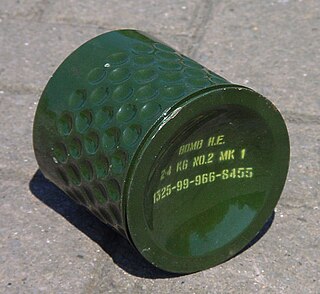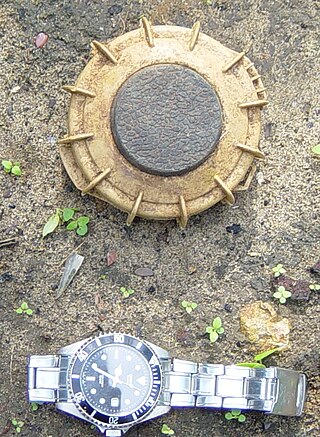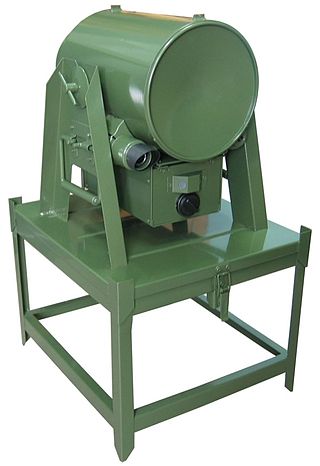Related Research Articles

The Claymore mine is a directional anti-personnel mine developed for the United States Armed Forces. Its inventor, Norman MacLeod, named the mine after a large medieval Scottish sword. Unlike a conventional land mine, the Claymore may be command-detonated, and is directional, shooting a wide pattern of metal balls into a kill zone. The Claymore can also be activated by a booby-trap tripwire firing system for use in area denial operations.
The GATOR mine system is a United States military system of air-dropped anti-tank and anti-personnel mines developed in the 1980s to be compatible with existing cluster dispensers. It is used with two dispenser systems—the Navy 230 kg (500 lb) CBU-78/B and the Air Force 450 kg (1,000 lb) CBU-89/B. Additionally the mines are used with the land- and helicopter-based Volcano mine system.

High-explosive anti-tank (HEAT) is the effect of a shaped charge explosive that uses the Munroe effect to penetrate heavy armor. The warhead functions by having an explosive charge collapse a metal liner inside the warhead into a high-velocity shaped charge jet; this is capable of penetrating armor steel to a depth of seven or more times the diameter of the charge. The shaped charge jet armor penetration effect is purely kinetic in nature; the round has no explosive or incendiary effect on the armor.

The Panzerfaust was a development family of single-shot man-portable anti-tank systems developed by Nazi Germany during World War II. The weapons were the first single-use light anti-tank weapons based on a pre-loaded disposable launch tube, a weapon configuration which is still used today.

The MON-50 is a Soviet rectangular, slightly concave, plastic bodied, directional type of anti-personnel mine designed to wound or kill by explosive fragmentation. It first entered service in 1965 and is a copy of the American M18 Claymore with a few differences. Its name is derived from Russian мина осколочная направленного, "directional fragmentation mine".

The MON-90 is a Claymore-shaped, plastic bodied, directional type of anti-personnel mine designed in the Soviet Union. It is designed to wound or kill by fragmentation. The mine is similar in appearance to the MON-50, but is approximately twice the size with a much greater depth.

The HB 876 mine was an air dropped area denial weapon. It was used as part of the JP233 runway denial system and the 'Hades' variant of the BL755 cluster bomb. As a result of the anti-personnel mine ban it was withdrawn from British Royal Air Force service, and the last stockpiles of the mine were destroyed on 19 October 1999.

An anti-personnel mine or anti-personnel landmine (APL) is a form of mine designed for use against humans, as opposed to an anti-tank mine, which target vehicles. APLs are classified into: blast mines and fragmentation mines; the latter may or may not be a bounding mine.
The APM-1, APM-2, APM-3, APM 19, and APM 29 are Austrian directional fragmentation mines similar to the United States Claymore mine. The mine's cases are made from moulded plastic and have convex faces. They contain a matrix of 5 millimeter diameter steel balls weighing 0.5 gram laid over a Composition B charge. When triggered the mines project the fragments in a horizontal arc of approximately 60 degrees.
The BAT/7 is a circular Italian plastic cased anti-tank landmine with a Misznay Schardin effect warhead. The mine's circumference has a large lip with ribs running vertically from it. The top surface of the mine also has a number of radial ribs with a central circular plate

The FFV 028 is a series of steel cased Swedish anti-tank mines that use electronic fuzes. The mines are circular, with a large Misznay Schardin effect warhead in the center of the mine, with the fuzing and sensor electronics located in the dead space above the main charge. The design of the mine dates from the 1970s and uses a magnetic influence sensor to detonate the mine, making it able to attack the full width of armoured vehicles.
The HAK-1 is a Hungarian plastic encased anti-tank mine. It uses a Misznay Schardin effect warhead combined with an electronic acoustic and magnetic influence fuze. The mine can be programmed for an active life of between three hours and 150 days. Once the acoustic sensor detects a target, the magnetic influence sensor is used to detonate the mine at the optimal point. The warhead is capable of penetrating 45 mm of armour and producing a 130 mm diameter hole.
The VS-HCT series of mines are Italian plastic cased anti-tank mines that use Misznay Schardin effect warheads and have a dual seismic and magnetic fuze. The mines are no longer produced and differ in size and shape.

The HPD-1, HPD-2 and HPD-3 are a series of French electrically fuzed anti-tank landmines of TDA Armements that use Misnay–Schardin effect warheads. The entire series of mines conform to the United States MIL-STD-331.
The Cardoen EC-2 mine is a Chilean directional fragmentation anti-personnel mine. It is broadly similar to the United States M18 Claymore mine.

Selectable Lightweight Attack Munition or is a small United States multi-purpose landmine produced by ATK Precision Fuze Company in Janesville, Wisconsin from 1992 to 2002. It has a passive infrared sensor, and a magnetic influence sensor which allow it to be used as a demolition munition, off-route mine, or full width belly attack mine.

The MPB is a Polish off-route anti-tank mine. It was developed by BELMA with its partner Military Institute of Engineer Technology. The MPB consists of a metal cylinder filled with explosives, mounted horizontally in an adjustable frame. The mine is intended to be hidden from direct view of the intended target, off to the side of a probable vehicle route, usually a road, to attack the weaker armour on the sides and rear of a vehicle. The mine can be triggered by either a contact fuze or an influence fuze based on infrared and acoustic sensors, and is also fitted with an anti-handling device. When used with the passive infrared fuze, an acoustic sensor detects approaching vehicles and activates the infrared sensor, which triggers the mine at an optimal moment as the target passes. The mine can be programmed to self-destruct after either 1, 10 or 30 days have passed.
The Helkir is an anti-helicopter mine developed by the Austrian company Hirtenberger. It uses an IR sensor and an acoustic sensor to detect airborne targets. Once the mine is armed and ready to engage, the acoustic sensor listens for a valid noise input. This enables the IR sensor which is located coaxially to the warhead. When the IR sensor detects a hot signature, the mine blasts off fragments that can penetrate up to 6 mm of armored steel at 50 meters and 2 mm of mild steel at 150 meters. The mine is active for a period of 1 to 120 days, after which it returns to a safe mode.

The MW-1 is a German munitions dispenser similar to the British JP233. It is designed to be carried on the Tornado IDS, although it can be carried on the Lockheed F-104 Starfighter and the McDonnell Douglas F-4 Phantom II. The MW-1 started to be phased out after the German Government ratified the Convention on Cluster Munitions in 2009.
Stonefish is a naval influence mine manufactured by British defence company BAE Systems. It has been exported to friendly countries such as Australia, which has both warstock and training versions of Stonefish. There has been conjecture that South Africa, Chile, Iraq, Libya and possibly other countries may have gained access to either some early Stonefish information or to similar technology. The mine is named after the venomous stonefish.
References
- Jane's Mines and Mine Clearance 2005-2006
- ↑ Anti-Helicopter Mine System Studies and Analyses, 1989 http://www.dtic.mil/dtic/tr/fulltext/u2/a278337.pdf
- ↑ "Archived copy". Archived from the original on 2013-03-01. Retrieved 2012-07-08.
{{cite web}}: CS1 maint: archived copy as title (link)